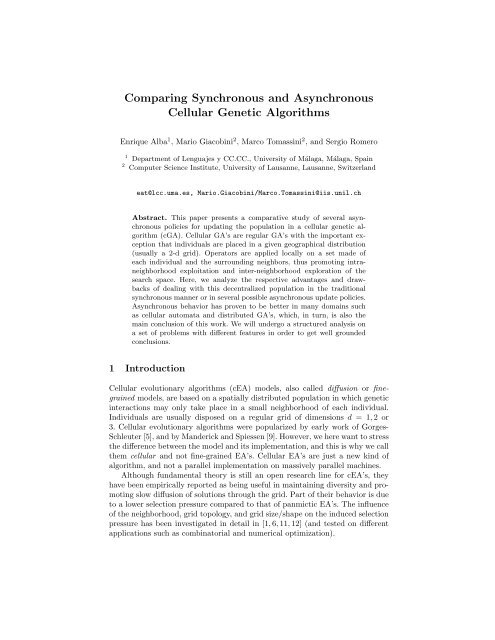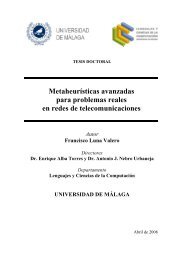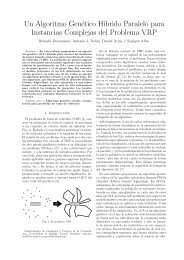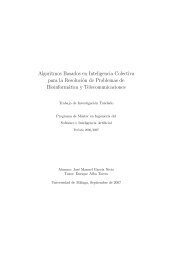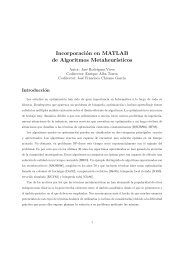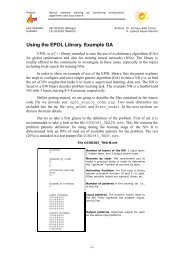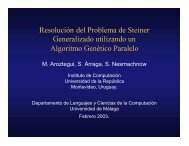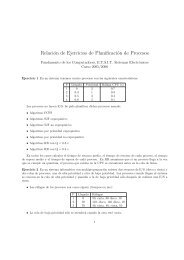Comparing Synchronous and Asynchronous Cellular Genetic ... - NEO
Comparing Synchronous and Asynchronous Cellular Genetic ... - NEO
Comparing Synchronous and Asynchronous Cellular Genetic ... - NEO
You also want an ePaper? Increase the reach of your titles
YUMPU automatically turns print PDFs into web optimized ePapers that Google loves.
<strong>Comparing</strong> <strong>Synchronous</strong> <strong>and</strong> <strong>Asynchronous</strong><br />
<strong>Cellular</strong> <strong>Genetic</strong> Algorithms<br />
Enrique Alba 1 , Mario Giacobini 2 , Marco Tomassini 2 , <strong>and</strong> Sergio Romero<br />
1 Department of Lenguajes y CC.CC., University of Málaga, Málaga, Spain<br />
2 Computer Science Institute, University of Lausanne, Lausanne, Switzerl<strong>and</strong><br />
eat@lcc.uma.es, Mario.Giacobini/Marco.Tomassini@iis.unil.ch<br />
Abstract. This paper presents a comparative study of several asynchronous<br />
policies for updating the population in a cellular genetic algorithm<br />
(cGA). <strong>Cellular</strong> GA’s are regular GA’s with the important exception<br />
that individuals are placed in a given geographical distribution<br />
(usually a 2-d grid). Operators are applied locally on a set made of<br />
each individual <strong>and</strong> the surrounding neighbors, thus promoting intraneighborhood<br />
exploitation <strong>and</strong> inter-neighborhood exploration of the<br />
search space. Here, we analyze the respective advantages <strong>and</strong> drawbacks<br />
of dealing with this decentralized population in the traditional<br />
synchronous manner or in several possible asynchronous update policies.<br />
<strong>Asynchronous</strong> behavior has proven to be better in many domains such<br />
as cellular automata <strong>and</strong> distributed GA’s, which, in turn, is also the<br />
main conclusion of this work. We will undergo a structured analysis on<br />
a set of problems with different features in order to get well grounded<br />
conclusions.<br />
1 Introduction<br />
<strong>Cellular</strong> evolutionary algorithms (cEA) models, also called diffusion or finegrained<br />
models, are based on a spatially distributed population in which genetic<br />
interactions may only take place in a small neighborhood of each individual.<br />
Individuals are usually disposed on a regular grid of dimensions d = 1, 2 or<br />
3. <strong>Cellular</strong> evolutionary algorithms were popularized by early work of Gorges-<br />
Schleuter [5], <strong>and</strong> by M<strong>and</strong>erick <strong>and</strong> Spiessen [9]. However, we here want to stress<br />
the difference between the model <strong>and</strong> its implementation, <strong>and</strong> this is why we call<br />
them cellular <strong>and</strong> not fine-grained EA’s. <strong>Cellular</strong> EA’s are just a new kind of<br />
algorithm, <strong>and</strong> not a parallel implementation on massively parallel machines.<br />
Although fundamental theory is still an open research line for cEA’s, they<br />
have been empirically reported as being useful in maintaining diversity <strong>and</strong> promoting<br />
slow diffusion of solutions through the grid. Part of their behavior is due<br />
to a lower selection pressure compared to that of panmictic EA’s. The influence<br />
of the neighborhood, grid topology, <strong>and</strong> grid size/shape on the induced selection<br />
pressure has been investigated in detail in [1, 6, 11, 12] (<strong>and</strong> tested on different<br />
applications such as combinatorial <strong>and</strong> numerical optimization).
Let us analyze a typical cGA, an important kind of cEA. The cGA iteratively<br />
considers groups of individuals belonging to the same neighborhood to work with.<br />
In a North-East-West-South (NEWS or Von Newmann) neighborhood type, the<br />
central individual plus its 4 neighbors make up a small pool to apply operators<br />
on. The cGA iterates through the population in various generations. In each<br />
generation, it considers as a central string every individual in the population.<br />
Since a string belongs to several neighborhoods, a change in its contents affects<br />
its neighbors in a smooth manner, representing a good tradeoff between slow<br />
convergence <strong>and</strong> good exploration of the search space. In a synchronous cGA,<br />
we compute the full new generation incrementally onto a temporary population,<br />
<strong>and</strong> them replace the full old population with the new one.<br />
<strong>Synchronous</strong> <strong>Cellular</strong> <strong>Genetic</strong> Algorithm (cGA)<br />
proc Reproductive_Cycle (ga):<br />
for s=1 to MAX_STEPS do<br />
for x=1 to WIDTH do<br />
for y=1 to HEIGHT do<br />
n_list = Calculate_neigbors (ga, position (x,y) );<br />
parent1 = Select (n_list);<br />
parent2 = Select (n_list);<br />
Crossover(ga.Pc, n_list[parent1], n_list[parent2], ind_aux.chrom);<br />
Mutate(ga.Pm, ind_aux.chrom);<br />
ind_aux.fitness = ga.Evaluate ( Decode ( ind_aux.chrom) ) ;<br />
Insert_New_Ind(position(x,y),ind_aux,[if better | always], ga, pop_aux);<br />
end_for;<br />
end_for;<br />
ga.pop=pop_aux;<br />
Collect_Statistics (ga);<br />
end_for;<br />
end_proc Reproductive_Cycle;<br />
<strong>Cellular</strong> EA’s can also be seen as stochastic cellular automata (CA’s) [15, 16]<br />
where the cardinality of the set of states is equal to the number of points in the<br />
search space. CA’s, as well as cEA’s, usually assume a synchronous or parallel<br />
update policy, in which all the cells are formally updated simultaneously. However,<br />
this is not the only option available. Indeed, several works on asynchronous<br />
CA’s have shown that sequential update policies have a marked effect on their<br />
dynamics (see e.g. [7, 13, 14]). While asynchronous updating is physically more<br />
realistic for CA’s due to their finite signal propagation speed, this is not an issue<br />
for cEA, unless they are implemented on an actual massively parallel cellular<br />
machine, which is seldom the case in practice. However, it would be interesting<br />
to investigate asynchronous cEA’s <strong>and</strong> their problem solving capabilities. To<br />
our knowledge, the present paper is the first step in that direction. We will thus<br />
present a few asynchronous update policies for a cEA, <strong>and</strong> compare them with<br />
the customary synchronous updating on a set of test functions.<br />
The paper is structured as follows. The next section contains some background<br />
on asynchronous cEA’s <strong>and</strong> explains the techniques we are considering.<br />
Section 3 describes the test problems used, while section 4 gives details on the<br />
cEA parameters employed in the simulations, the performance measures, <strong>and</strong><br />
the statistics used. Section 5 contains a discussion of the experimental results,<br />
<strong>and</strong> section 6 offers our conclusions, as well as some comments on the future<br />
work.
2 <strong>Asynchronous</strong> <strong>Cellular</strong> Evolutionary Algorithms<br />
There are many ways for sequentially updating the cells of a cEA with a population<br />
on a 2-d grid (see an excellent discussion of asynchronous CA’s in [13]).<br />
The most general one is independent r<strong>and</strong>om ordering of updates in time, which<br />
consists in r<strong>and</strong>omly choosing the cell to be updated next, with replacement.<br />
This corresponds to a binomial distribution for the update probability. The limiting<br />
case of such distribution for large n is the Poisson distribution (where n<br />
is the number of cells, or individuals, in the grid). This update policy will be<br />
called uniform choice (UC) in the following.<br />
For comparison purposes we also consider three other update methods: fixed<br />
line sweep, fixed r<strong>and</strong>om sweep <strong>and</strong> r<strong>and</strong>om new sweep (we employ the same<br />
terms as in [13]).<br />
– In fixed line sweep (LS), the simplest method, grid cells are updated sequentially<br />
(1, 2 . . . n), line by line of the 2-d grid.<br />
– In the fixed r<strong>and</strong>om sweep update (FRS), the next cell to be updated is<br />
chosen with uniform probability without replacement; this will produce a<br />
certain update sequence (c j<br />
1 , ck 2, . . . , c m n ), where c p q means that cell number p<br />
is updated at time q <strong>and</strong> (j, k, . . . , m) is a permutation of the n cells. The<br />
same permutation is then used for the following update cycles.<br />
– The new r<strong>and</strong>om sweep method (NRS) works like FRS, except that a r<strong>and</strong>om<br />
new cell permutation is chosen anew for each sweep through the array.<br />
A time step is defined to be the action of updating n times, which corresponds<br />
to updating all the n cells in the grid for LS, FRS <strong>and</strong> NRS, <strong>and</strong> possibly<br />
less than n different cells in the uniform choice method, since some cells might<br />
be updated more than once. It should be noted that, with the exception of<br />
fixed line sweep, the other asynchronous updating policies are non-deterministic,<br />
representing an additional source of non-determinism besides that of the genetic<br />
operators. An asynchronous parallel implementation could be easily derived for<br />
these algorithms, although we do not explore physical parallelism in this work.<br />
3 Description of the Test Problems<br />
To test the differences between the synchronous <strong>and</strong> the four asynchronous update<br />
models we have decided to use problems representing three large classes of<br />
difficulty with interest in evolutionary computation, namely: deception, multimodality,<br />
<strong>and</strong> epistasis. Similarly to the work of Alba <strong>and</strong> Troya [1], the choice<br />
has been driven to the Massive Multimodal Deceptive Problem (MMDP), the<br />
Frequency Modulation Sounds Problem (FMS), <strong>and</strong> the P-PEAKS multimodal<br />
generator.<br />
The MMDP has been specifically designed by Goldberg et al. [4] to be difficult<br />
for an EA. It is made up of k subproblems of 6 bits each (see equation<br />
1). The optimum has a value of k <strong>and</strong> is attained when the unitation of each<br />
subproblem, i.e. the number of ones of its 6-bits defining string, is 0 or 6. Thus
every subproblem xi =< xi1, ..., xi6 > (i = 1, ..., k) contributes to the fitness of<br />
a possible solution −→ x =< x1...xk > according to its unitation:<br />
fMMDP ( −→ x ) =<br />
k<br />
g(unitation(xi)), (1)<br />
i=1<br />
where g is such that g(0) = g(6) = 1, g(1) = g(5) = 0, g(2) = g(4) = 0.36,<br />
g(3) = 0.64. Such function has a quite large number of local optima (22 k ), while<br />
only 2 k are global solutions, <strong>and</strong> therefore its degree of multimodality is defined<br />
by k. Here we set k = 40, obtaining a considerably large degree of multimodality.<br />
Proposed by Tsutsui et al. [10], the Frequency Modulation Sounds parameter<br />
identification problem (FMS) consists in adjusting a general model y(t) (equation<br />
2) to a basic sound function y0(t) (equation 3). The problem is to evolve a<br />
solution −→ x consisting in 6 real parameters ( −→ x =< a1, w1, a2, w2, a3, w3 >) each<br />
one encoded with 32 bits in the range [−6.4, 6.35], in order y(t) to fit the target<br />
function y0(t).<br />
y(t) = a1 sin(w1tθ + a2 sin(w2tθ + a3 sin(w3tθ))), (2)<br />
y0(t) = 1.0 sin(5.0tθ + 1.5 sin(4.8tθ + 2.0 sin(4.9tθ))). (3)<br />
The goal is, therefore, to minimize the sum of square errors (equation 4):<br />
fF MS( −→ 100<br />
x ) = (y(t) − y0(t)) 2 . (4)<br />
t=0<br />
The resulting problem is a complex multimodal function having strong epistasis<br />
with minimum value in −→ z , where f( −→ z ) = 0. For our calculations, we consider<br />
the algorithm having found an optimum when the error falls below 10 −2 .<br />
The last optimization task solved in this paper is a problem generator proposed<br />
by De Jong et al. [8]. This problem generator is an easily parameterizable<br />
task which has a tunable degree of epistasis, thus allowing to derive instances<br />
with growing difficulty at will. With a problem generator we evaluate our algorithms<br />
on a high number of r<strong>and</strong>om problem instances, thus increasing the<br />
predictive power of the results for the problem class as a whole. Such a characteristic<br />
allows a larger fairness when comparing algorithms, since it implicitly<br />
removes the opportunity to h<strong>and</strong>-tune algorithms to a particular problem. In<br />
this paper we use the multimodal generator called P-PEAKS (see equation 5).<br />
fP −P EAKS( −→ x ) = 1<br />
N maxp<br />
i=1 {N − HammingD(−→ x , P eaki)} (5)<br />
The idea is to generate P strings, each of N r<strong>and</strong>om bits, that represent<br />
the location of the global optima in the search space. The fitness of a possible<br />
solution (a bit string of length N) is the number of bits it has in common with<br />
the nearest peak in the Hamming space, divided by the length N of the strings.<br />
Problems with a small/large number of peaks are weakly/strongly epistatic. The<br />
instance we use has P = 100 peaks of N = 100 bits each, which represents a<br />
medium-high epistasis level.
4 Parameters <strong>and</strong> Statistics Used<br />
As we said in the introduction, many authors have already investigated the<br />
influence of the neighborhood, grid topology <strong>and</strong> grid dimensions on the induced<br />
selection pressure [1, 6, 11, 12]. Reduced grid dimensions of 20×20 have been used<br />
to design efficient cGA’s [1], but, most of the time, larger grids are preferred for<br />
the analysis. For the three problems described in section 3 we have investigated<br />
four different grid sizes, so as to choose the dimension that, for all the problems,<br />
guarantees significant success rate of the five update methods. Each grid size has<br />
been tested 50 times for each update method.<br />
MMDP <strong>Synchronous</strong> Line Sweep Fixed R<strong>and</strong>om Sweep New R<strong>and</strong>om Sweep Uniform Choice<br />
20 × 20 0% 0% 0% 0% 0%<br />
32 × 32 74% 32% 38% 44% 56%<br />
40 × 40 98% 86% 92% 84% 94%<br />
50 × 50 100% 98% 100% 100% 100%<br />
Table 1. Success rate for the Massive Multimodal Deceptive Problem of the synchronous<br />
<strong>and</strong> the four asynchronous update methods (horizontally) with different grid<br />
dimensions (vertically).<br />
All the results are summarized in tables 1, 2 <strong>and</strong> 3 <strong>and</strong> were obtained with<br />
the same internal parameters. For the parent’s selection we have used a roulette<br />
wheel operator among the five individuals in the von Neumann neighborhood<br />
(the central plus the four neighbors in the North, East, West <strong>and</strong> South positions).<br />
A two point crossover is applied to the two selected parents with probability<br />
1.0, thus producing an offspring individual (the one with the largest<br />
proportion of the best parent). Such a new solution is then mutated with different<br />
mutation probabilities pm for the three problems. The obtained offspring<br />
will replace the considered individual only if it has a better fitness. We stop<br />
the algorithm when a global optimum is found, <strong>and</strong> we analyze the cost of a<br />
successful run of a cEA by measuring the number of evaluations done. In the<br />
MMDP, an individual is encoded by a 40 × 6 = 240 bit string, in the FMS problem<br />
by a 6 × 32 = 192 binary chromosome, <strong>and</strong> in the P-PEAKS problem by<br />
a binary vector of length 100. The problems’ differences <strong>and</strong> the different chromosomal<br />
lengths determine three mutation probabilities: for the MMDP <strong>and</strong><br />
the P-PEAKS problem we set pm to 1/L, having respectively pm = 0.0042 <strong>and</strong><br />
pm = 0.01, while for the FMS problem pm is set to 10/L, i.e. pm = 0.052.
FMS <strong>Synchronous</strong> Line Sweep Fixed R<strong>and</strong>om Sweep New R<strong>and</strong>om Sweep Uniform Choice<br />
20 × 20 0% 0% 0% 2% 0%<br />
32 × 32 4% 0% 2% 0% 2%<br />
40 × 40 8% 8% 6% 8% 6%<br />
50 × 50 24% 22% 12% 12% 12%<br />
Table 2. Success rate for the Frequency Modulation Sounds problem of the synchronous<br />
<strong>and</strong> the four asynchronous update methods (horizontally) with different grid<br />
dimensions (vertically).<br />
P-PEAKS <strong>Synchronous</strong> Line Sweep Fixed R<strong>and</strong>om Sweep New R<strong>and</strong>om Sweep Uniform Choice<br />
20 × 20 52% 26% 36% 34% 36%<br />
32 × 32 100% 100% 100% 100% 100%<br />
40 × 40 100% 100% 100% 100% 100%<br />
50 × 50 100% 100% 100% 100% 100%<br />
Table 3. Success rate for the P-PEAKS problem of the synchronous <strong>and</strong> the four<br />
asynchronous update methods (horizontally) with different grid dimensions (vertically).<br />
Capcarrère et al. defined a number of statistical measures that are useful for<br />
underst<strong>and</strong>ing the dynamical behavior of cellular evolutionary algorithms. Two<br />
kinds of statistics were used: genotypic <strong>and</strong> phenotypic. Genotypic measures embody<br />
aspects related to the genotypes of individuals in a population. Phenotypic<br />
statistics concern properties of individual performance, essentially fitness (see [3]<br />
for the exact definitions). Here, we use the variance <strong>and</strong> the mean fitness as phenotypic<br />
statistics, <strong>and</strong> the entropy as a statistics pertaining to the genotype (a<br />
phenotypic diversity index based on fitness entropy can also be defined but it<br />
will not be used here). Differently from the paper of Capcarrère et al., we calculate<br />
the entropy in the interval [0, 1], instead of in the interval [0, log(N)] (where<br />
N is the population size). Such a result is obtained setting the multiplicative<br />
constant in the entropy formula to 1/ log(N) instead of using 1.<br />
5 Experimental Results<br />
In order to have comparable results for all the three problems, we have decided<br />
to set the population to the 50 × 50 grid size (non-square grids analyzed in [1]).<br />
The results, for all the runs, are summarized in table 4: for each update method<br />
the average number of evaluations needed to solve the three problems is shown.<br />
For the MMDP <strong>and</strong> the P-PEAKS problem, where success rate is 100%,<br />
we can see that the synchronous update method is more expensive than every<br />
asynchronous method. We can therefore deduce that for multimodal, deceptive<br />
(MMDP) <strong>and</strong> highly epistatic (P-PEAKS) problems it should be more efficient<br />
to implement an asynchronous update method rather than a synchronous one.
<strong>Synchronous</strong> Line Sweep Fixed R<strong>and</strong>om Sweep New R<strong>and</strong>om Sweep Uniform Choice<br />
MMDP 277950 201887 216300 217850 238850<br />
FMS 560760 543928 427291 480500 534772<br />
P-PEAKS 243300 189550 191700 201400 203350<br />
Table 4. Mean number of evaluations for the three problems (vertically) <strong>and</strong> the five<br />
update methods (horizontally).<br />
The behavior of these two problems is slightly different for each asynchronous<br />
updating policy. For MMDP <strong>and</strong> P-PEAKS the Line Sweep method is the fastest<br />
policy, <strong>and</strong> the New R<strong>and</strong>om Sweep is faster than Uniform Choice. The Fixed<br />
R<strong>and</strong>om Sweep policy has a convergence speed similar to the Line Sweep for the<br />
highly epistatic problem, <strong>and</strong> to the New R<strong>and</strong>om Sweep for the multimodal<br />
<strong>and</strong> deceptive problems. Such a different speed can be seen in figure 1, where<br />
a sample curve is drawn for each update method, both for MMDP (a) <strong>and</strong> for<br />
P-PEAKS (b).<br />
fitness<br />
40<br />
35<br />
30<br />
25<br />
(a) MMDP<br />
SYN<br />
LS<br />
FRS<br />
NRS<br />
UC<br />
20<br />
0 100 200 300<br />
evaluations (x10 3 )<br />
fitness<br />
1<br />
0.95<br />
0.9<br />
0.85<br />
0.8<br />
0.75<br />
(b) P−PEAKS<br />
SYN<br />
LS<br />
FRS<br />
NRS<br />
UC<br />
0.7<br />
0 100 200 300<br />
evaluations (x10 3 )<br />
Fig. 1. A sample run of each update method for the MMDP (a), <strong>and</strong> for the P-PEAKS<br />
problem (b).<br />
This difference in the speed of convergence is followed by a consistent behavior<br />
of the entropy curves (see figure 2): the faster the convergence speed is, the<br />
lower the entropy is. Such a result confirms the intuitive idea that the genotypic<br />
diversity decreases proportionally to the convergence speed, i.e. the faster a cEA<br />
is, the bigger the upward thrust of the populations is. The variance <strong>and</strong> the<br />
st<strong>and</strong>ard deviation values are consistent with the described behaviors.<br />
For the FMS problem the comparison between the convergence speeds of the<br />
different update methods must be coupled with their different success rates. In<br />
fact, as it can be seen comparing tables 2 <strong>and</strong> 4, the synchronous <strong>and</strong> the Line
population entropy<br />
1<br />
0.9<br />
0.8<br />
0.7<br />
0.6<br />
0.5<br />
(a) MMDP<br />
SYN<br />
LS<br />
FRS<br />
NRS<br />
UC<br />
0.4<br />
0 100 200 300<br />
evaluations (x10 3 )<br />
population entropy<br />
1<br />
0.9<br />
0.8<br />
0.7<br />
0.6<br />
0.5<br />
(b) P−PEAKS<br />
SYN<br />
LS<br />
FRS<br />
NRS<br />
UC<br />
0.4<br />
0 100 200 300<br />
evaluations (x10 3 )<br />
Fig. 2. A sample curve of the entropy of each update method for the MMDP (a) <strong>and</strong><br />
for the P-PEAKS problem (b).<br />
Sweep methods are slower than the Fixed R<strong>and</strong>om Sweep, the New R<strong>and</strong>om<br />
Sweep <strong>and</strong> the Uniform Choice methods (see also figure 3), but their success<br />
rate are twice the percentage of the other three asynchronous update methods.<br />
So, Line Sweep seems a good tradeoff between speed <strong>and</strong> accuracy, at least for<br />
problems similar to FMS. FMS showed to be the most difficult problem on which<br />
our cEA’s have been tested in this study, due to its huge <strong>and</strong> complex search<br />
space. The entropy at the end (not shown here) is always very high, in the<br />
interval [0.9, 0.92] for every algorithm.<br />
fitness<br />
30<br />
25<br />
20<br />
15<br />
10<br />
5<br />
FMS<br />
synchronous<br />
Line Sweep<br />
Fixed R<strong>and</strong>om Sweep<br />
New R<strong>and</strong>om Sweep<br />
Uniform Choice<br />
0<br />
0 100 200 300 400 500 600 700<br />
evaluations (x10 3 )<br />
Fig. 3. A sample run of each update method for the FMS problem.
We have seen that, contrary to the behavior of cellular automata (CA’s), the<br />
simple Line Sweep policy performs better than the rest in cEA’s. Such a result<br />
can be explained by the fact that, in cEA’s, we don’t have a propagation of signals<br />
like in CA’s, having instead a propagation of information on the solution of the<br />
problem. It is true that Line Sweep fixes a preferred direction of propagation in<br />
the axes of the grid, but such an order speeds the propagation of information<br />
in the population. In fact, if we take our 50 × 50 toroidal population grids with<br />
the chosen von Neumann neighborhood, in synchronous cEA’s the information<br />
of an individual will take at least 50 time steps (i.e. 125000 evaluations) to<br />
reach the farthest individual in the grid, while in a cEA with asynchronous Line<br />
Sweep update method, it can take a small value such as 1 time step (i.e. 2500<br />
evaluations).<br />
6 Conclusions<br />
In this paper we have analyzed the behavior of three alternative policies for<br />
asynchronously updating the population of a decentralized cellular GA. We have<br />
initiated this research line because we had some preliminary expectations relating<br />
asynchronous policies in the field of cellular automata [14] <strong>and</strong> distributed GA’s<br />
[2]. We have tackled this study by considering three representative problems:<br />
deceptive (MMDP), epistatic (P-PEAKS) <strong>and</strong> hard (FMS) problems. Our first<br />
conclusion is that, for any size of the search grid, the synchronous update policy<br />
is the best in terms of percentage of hits, because it always provides an equal or<br />
larger success rate with respect to any of the asynchronous policies.<br />
However, if we consider the number of evaluations needed to locate the optimum<br />
(efficiency) we got the opposite conclusion: asynchronous methods are<br />
faster (sometimes much faster) than the synchronous one. A simple asynchronous<br />
policy such that Line Sweep (LS) provides the faster convergence for two of the<br />
problems (MMDP <strong>and</strong> P-PEAKS), while it shows a high <strong>and</strong> desirable success<br />
rate (similar to that of the synchronous update). In the hard FMS problem,<br />
Fixed R<strong>and</strong>om Sweep got a considerably faster solution, <strong>and</strong> can be pointed out<br />
as a good approach.<br />
Globally stated, fast convergence means local optima in evolutionary algorithms,<br />
but cellular GA’s in general, <strong>and</strong> the Line Sweep policy in particular,<br />
offers a good tradeoff solution to this problem without bothering researchers<br />
with a large number of parameters to be tuned (maybe only the ratio between<br />
the size of the grid <strong>and</strong> the neighborhood being used [1]).<br />
As a future work, we will enlarge the set of considered problems, include a<br />
study of the influence of the shape of the 2-d grid containing the population,<br />
<strong>and</strong> try to better characterize the relationship between the performance measures<br />
<strong>and</strong> the kind of problems.<br />
References<br />
1. E. Alba <strong>and</strong> J. M. Troya. <strong>Cellular</strong> evolutionary algorithms: Evaluating the influence<br />
of ratio. In M. Schoenauer et al., editor, Parallel Problem Solving from
Nature, PPSN VI, volume 1917 of Lecture Notes in Computer Science, pages 29–<br />
38. Springer-Verlag, 2000.<br />
2. E. Alba <strong>and</strong> J. M. Troya. Analyzing synchronous <strong>and</strong> asynchronous parallel distributed<br />
genetic algorithms. Future Generation Computer Systems, 17:451–465,<br />
January 2001.<br />
3. M. Capcarrère, M. Tomassini, A. Tettamanzi, <strong>and</strong> M. Sipper. A statistical study<br />
of a class of cellular evolutionary algorithms. Evolutionary Computation, 7(3):255–<br />
274, 1999.<br />
4. K. Deb D.E. Goldberg <strong>and</strong> J. Horn. Massively multimodality, deception <strong>and</strong> genetic<br />
algorithms. In R. Männer <strong>and</strong> B. M<strong>and</strong>erick, editors, Proceedings of the PPSN II,<br />
pages 37–46. North-Holl<strong>and</strong>, 1992.<br />
5. M. Gorges-Schleuter. ASPARAGOS an asynchronous parallel genetic optimisation<br />
strategy. In J. D. Schaffer, editor, Proceedings of the Third International Conference<br />
on <strong>Genetic</strong> Algorithms, pages 422–427. Morgan Kaufmann, 1989.<br />
6. M. Gorges-Schleuter. An analysis of local selection in evolution strategies. In<br />
<strong>Genetic</strong> <strong>and</strong> evolutionary conference, GECCO99, volume 1, pages 847–854. Morgan<br />
Kaufmann, San Francisco, CA, 1999.<br />
7. T. E. Ingerson <strong>and</strong> R. L. Buvel. Structure in asynchronous cellular automata.<br />
Physica D, 10:59–68, 1984.<br />
8. K.A. De Jong, M.A. Potter, <strong>and</strong> W.M. Spears. Using problem generators to explore<br />
the effects of epistasis. In T. Bäck, editor, Proceedings of the Seventh ICGA, pages<br />
338–345. Morgan Kaufmann, 1997.<br />
9. B. M<strong>and</strong>erick <strong>and</strong> P. Spiessens. Fine-grained parallel genetic algorithms. In J. D.<br />
Schaffer, editor, Proceedings of the Third International Conference on <strong>Genetic</strong> Algorithms,<br />
pages 428–433. Morgan Kaufmann, 1989.<br />
10. D. Corne S. Tsutsui, A. Ghosh <strong>and</strong> Y. Fujimoto. A real coded genetic algorithm<br />
with an explorer <strong>and</strong> an exploiter populations. In T. Bäck, editor, Proceedings of<br />
the Seventh ICGA, pages 238–245. Morgan Kaufmann, 1997.<br />
11. J. Sarma <strong>and</strong> K. A. De Jong. An analysis of the effect of the neighborhood size <strong>and</strong><br />
shape on local selection algorithms. In H. M. Voigt, W. Ebeling, I. Rechenberg,<br />
<strong>and</strong> H. P. Schwefel, editors, Parallel Problem Solving from Nature (PPSN IV), volume<br />
1141 of Lecture Notes in Computer Science, pages 236–244. Springer-Verlag,<br />
Heidelberg, 1996.<br />
12. J. Sarma <strong>and</strong> K. A. De Jong. An analysis of local selection algorithms in a spatially<br />
structured evolutionary algorithm. In T. Bäck, editor, Proceedings of the<br />
Seventh International Conference on <strong>Genetic</strong> Algorithms, pages 181–186. Morgan<br />
Kaufmann, 1997.<br />
13. B. Schönfisch <strong>and</strong> A. de Roos. <strong>Synchronous</strong> <strong>and</strong> asynchronous updating in cellular<br />
automata. BioSystems, 51:123–143, 1999.<br />
14. M. Sipper, M. Tomassini, <strong>and</strong> M. S. Capcarrere. Evolving asynchronous <strong>and</strong> scalable<br />
non-uniform cellular automata. In G. D. Smith, N. C. Steele, <strong>and</strong> R. F.<br />
Albrecht, editors, Proceedings of International Conference on Artificial Neural Networks<br />
<strong>and</strong> <strong>Genetic</strong> Algorithms (ICANNGA97), pages 67–71. Springer-Verlag, Vienna,<br />
1997.<br />
15. M. Tomassini. The parallel genetic cellular automata: Application to global function<br />
optimization. In R. F. Albrecht, C. R. Reeves, <strong>and</strong> N. C. Steele, editors,<br />
Proceedings of the International Conference on Artificial Neural Networks <strong>and</strong> <strong>Genetic</strong><br />
Algorithms, pages 385–391. Springer-Verlag, 1993.<br />
16. D. Whitley. <strong>Cellular</strong> genetic algorithms. In S. Forrest, editor, Proceedings of the<br />
Fifth International Conference on <strong>Genetic</strong> Algorithms, page 658. Morgan Kaufmann<br />
Publishers, San Mateo, California, 1993.


